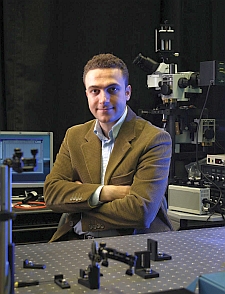Researchers at University of California at Los Angeles (UCLA) have built a compact, light-weight microscope that uses holograms instead of lenses. The device is described in a paper published today in the journal Biomedical Optics Express, and a company has been formed to take it to market.
The team developing the microscope is led by UCLA’s Aydogan Ozcan (pictured left), professor of electrical and bioengineering. They designed the device to serve remote areas of the world, doctors, nurses, and field workers who need equipment that is portable, versatile, and relatively inexpensive.
Ozcan’s team has so far built a prototype that weighs about as much as a banana and fits in the palm of a hand. The device is based in part on mass-produced consumer electronics, thus the materials in the microscope cost between $50.00 and $100.00.
The microscope can work in two different ways. In a transmission mode, the device can be used to probe relatively large volumes of blood or water. In a separate reflection mode, it can image denser, opaque samples. The spatial resolution for both modes is less than two micrometers, comparable to resolutions achieved by bulkier microscopes with low- to medium-power lenses.
The device’s small size and light weight is a result of replacing traditional (and heavy) lenses with holograms. In holograms, light passing through a three-dimensional object interferes with a reference beam that does not hit the object. An analysis of the pattern of interference from the beams can trace back the light sources and recreate an image of the original object.
Ozcan’s microscope works much the same way. A light source is divided into two beams: one that interacts with microscopic cells or particles in the sample, and the other that does not. The beams then pass to an adjacent sensor chip, where their interference pattern is recorded. Software can then analyze that pattern and recreates the path taken by the light that passed through or bounced off the objects being imaged.
The microscope takes advantage of inexpensive materials and software to keep the cost of the device low. Ozcan says the laser light source could come from a $5.00 laser pointer. The sensor chip that collects that light is the same as the ones in the backs of iPhones and Blackberries and costs less than $15.00 per chip. And the whole image-collecting system can run on two AA batteries.
The software to analyze and reconstruct the image would be provided by an Internet-connected computer. Workers in the field could use their laptops or hand-held devices to process the information or send it over the Internet or mobile phone networks to a remote server.
The development team plans to commercialize the device. Ozcan says he has founded a company that is further developing the microscope technology into a version for manufacture and sale to health care workers and hobbyists.
Read more: University Engineers Develop Single Lens for 3D Microscope
* * *


 RSS - Posts
RSS - Posts
You must be logged in to post a comment.